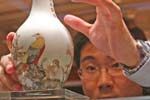Raise a toast to Portuguese, Italian wines
Updated: 2011-04-01 10:56
(China Daily European Weekly)
Wine consumption in China is growing with record sales and output, despite stiff competition among brands for market share.
French style wines are the most popular in the Chinese market, with domestic brands accounting for the lion's share. Italian and Portugese wines are now attempting to thwart the dominance of domestically produced French wine in China.
 |
|
Asti sparkling white wine by Gancia. |
"We see a great opportunity for Portuguese wine in China because of the nation's diversity, history and characteristics. We have a rich tradition of producing great wines, such as the Porto and Douro," Osorio says. "Our brands also have quality certification and superior taste." The Porto and Douro are already doing well in Macao and Hong Kong, he says.
Porto wine is a sweet red "liquor" wine with 20 percent alcohol per volume, while the Douro variety is available in both white and red varieties.
Lamberto Gancia, managing director of the family-owned Italian wine maker Gancia, says that the time is right to introduce Chinese consumers to different tastes. Gancia says he is keen on introducing Italian sparkling wines in China.
"Gancia invented Asti, a white sparkling wine, in 1865. So we have long experience, the necessary know-how and the lineage to produce with success wines that match the Chinese palate and cuisine," Gancia says.
"Gancia also produces high quality red still wines that represent 80 percent of the Chinese market consumption. These wines are distributed through a network of local distributors that we have selected during the last few years, so we see a good opportunity for our range of sparkling wines, dry, sweet and Prosecco and for our range of red wines."
Portuguese wines so far have entered the mainland market through Hong Kong and Macao, and imports on a small scale are coming through Shanghai. Gancia, on the other hand has barely entered the mainland and is only available through specialty importers.
Both Gancia and Osorio hope to educate Chinese consumers and show them the light of their wines. They are targeting a younger, more worldly consumer who is interested in quality for money, and price their products in the medium to high price range.
Education is of course key to their success, as Gancia and Osorio are presenting wines that are sweeter to the taste and very different from the norm, but it ultimately comes down to just getting the consumer to drink wine.
China Daily
E-paper

Green light
F1 sponsors expect lucrative returns from Shanghai pit stop
Buying into the romance
Born to fly
Light of hope
Specials

Share your China stories!
Foreign readers are invited to share your China stories.

No more Mr. Bad Guy
Italian actor plans to smash ‘foreign devil’ myth and become the first white kungfu star made in China.

Art auctions
China accounted for 33% of global fine art sales.
